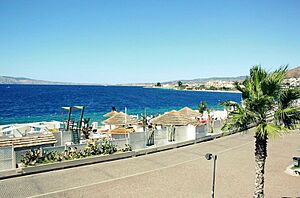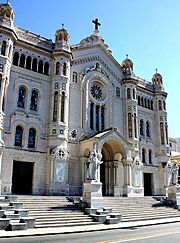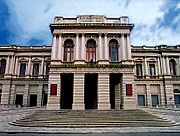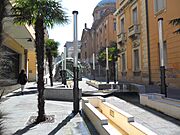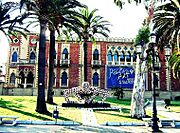Reggio Calabria facts for kids
Quick facts for kids
Reggio Calabria
|
|||
|---|---|---|---|
| Città di Reggio Calabria | |||
|
Clockwise from top: Aerial view, Lungomare Falcomatà, Castello Aragonese, the historical Roman baths of Reggio Calabria, Monument to Victory in Arena dello Stretto, Giuseppe Garibaldi square and the Centrale railway station, Reggio Calabria Cathedral, statue in Piazza Italia
|
|||
|
|||
| Nickname(s):
the city of Fata Morgana
|
|||
| Country | Italy | ||
| Region | Calabria | ||
| Area | |||
| • Total | 240 km2 (90 sq mi) | ||
| Population
((2023 estimate))
|
|||
| • Total | 170,951 | ||
| • Density | 712/km2 (1,840/sq mi) | ||
| Demonym(s) | Reggino | ||
| Time zone | UTC+1 (CET) | ||
| • Summer (DST) | UTC+2 (CEST) | ||
| Postal code |
89100 (generic)
from 89121 to 89135 |
||
| Dialing code | 0039 0965 | ||
| Website | reggiocal.it | ||
Reggio Calabria is a large city in Calabria, a region in southern Italy. It's often simply called Reggio by the people who live there. With a population of about 170,000, it's one of Italy's most populated cities. Reggio Calabria is located right at the "toe" of the Italian Peninsula. It's separated from the island of Sicily by a narrow stretch of water called the Strait of Messina. The city sits on the slopes of the Aspromonte mountains.
Reggio is the oldest city in its region. In ancient times, it was a very important Greek colony called Magna Graecia. The city has been rebuilt many times, especially after a huge earthquake in 1908. This earthquake destroyed most of the city, leading to its modern layout with straight streets. Because of its location near a faultline, earthquakes have always been a part of its history.
Today, Reggio is an important center for services and transportation in southern Italy. It's home to the famous National Archaeological Museum of Magna Græcia. This museum displays ancient Greek artifacts, including the amazing Bronzes of Riace, which are ancient Greek statues. These bronzes have become a symbol of the city. Reggio is also known for its unique nicknames: "city of Bronzes," "city of bergamot" (a special citrus fruit grown here), and "city of Fatamorgana" (a cool optical illusion seen from its coast).
Contents
What's in a Name?
Reggio Calabria has had many different names throughout its long 3,500-year history. Each name tells a bit about the city's past:
- Erythra: This was the name of the settlement before the Greeks arrived. It means 'red' in Greek.
- Rhegion: This was the name given by the Greeks from the 8th to the 3rd centuries BC.
- Phoibeia: A short-lived name from the 4th century BC, named after the Greek god Apollo.
- Regium or Rhegium: The first Latin names used by the Romans.
- Rhegium Julii: A Roman name given during the time of the Roman Empire, honoring Julius Caesar.
- Riyyu: The Arabic name when the city was briefly ruled by the Emirate of Sicily.
- Rìsa: The name used under the Normans.
- Regols: The Catalan name when the city was part of the Crown of Aragon.
- Reggio or Regio: Common Italian names used during the Middle Ages and modern times.
- Reggio di Calàbria: The name given after Italy became a unified country, to tell it apart from other cities named Reggio.
The name "Reggio" might come from an ancient Italian word "rec," meaning 'king'. Some ancient Greek and Roman thinkers believed it came from the Greek word "regnynai," meaning 'break'. This referred to a myth about an earthquake that supposedly broke Sicily away from the Italian mainland.
A Look Back in Time
Reggio Calabria has a very long and interesting history, going back thousands of years.
Ancient Beginnings
Before the Greeks arrived around 700 BC, different groups of people lived in the area. The land around Reggio was sometimes called Saturnia or Neptunia. The name 'Italia' (Italy) first referred only to the area around Reggio before it grew to mean the whole Italian peninsula.
Reggio was one of the first Greek colonies in southern Italy. It was founded by people from Chalcis in 730 or 743 BC. The city was called "Rhegion." It became one of the most important cities in Magna Graecia (Greater Greece), which was the name for the Greek colonies in southern Italy.
Under a ruler named Anaxilas (494-476 BC), Rhegion became very powerful. It even took control of Messina, across the Strait. Later, during the Peloponnesian War, Rhegion sided with Athens. The city was destroyed by Dionysius I of Syracuse in 387 BC but was later rebuilt.
Rhegion was a center for art, philosophy, and science. Famous people like the poet Ibycus and the sculptors Pythagoras and Clearchus lived there.
In 282 BC, Rhegion became an ally of the Roman republic. It kept its Greek customs and language. The city was an important hub for trade and travel. The apostle St. Paul even passed through Rhegium on his way to Rome in AD 61. In Roman times, the city had nine public baths, and you can still see the remains of one today. Earthquakes often damaged the city throughout its history.
The Middle Ages
Many different armies came to Reggio during the early Middle Ages because of its important location. It was ruled by the Byzantine Empire for a long time, becoming a major cultural center. Greek traditions and language stayed strong here for centuries.
In 918 AD, Arabs took over Reggio for a short time. They brought new ideas, like citrus fruits, mulberry trees for silk production, and new cooking methods. They also introduced water ices and improved farming techniques.
In 1060, the Normans captured Reggio. Later, the city was ruled by the Hohenstaufen family and then the Angevins. In the 14th century, Reggio supported the Aragonese forces. The Aragonese even made the city's medieval castle bigger in 1459.
Reggio was also an important center for writing and printing. The first dated Hebrew book was printed here in 1475. The Jewish community in Reggio was famous for dyeing and trading silk, which was highly valued across Europe.
Later History and Modern Times
From the 16th century, Reggio was under Spanish rule. This was a difficult time with high taxes, diseases, earthquakes, and attacks by Ottoman Turks. In 1534, the Ottoman fleet burned the town.
In the 18th century, the city was ruled by the Austrians and then the Bourbons of Spain. A terrible earthquake in 1783 caused a lot of damage to Reggio and the surrounding areas.
The special citrus fruit, bergamot, has been grown in Reggio since the 15th century. By 1750, it was being grown in large farms and was the first of its kind in the world.
In 1806, Napoleon Bonaparte took control of Reggio. After Napoleon's defeat, Reggio became part of the Kingdom of the Two Sicilies. In the 19th century, the city grew with new gardens, squares, cafes, and a theater.
The Great Earthquake of 1908
On December 28, 1908, a massive earthquake hit Reggio at 5:21 am. It shook violently for 31 seconds. The damage was even worse in Messina, across the Strait. About 25,000 people died in Reggio, and 65,000 in Messina. Ten minutes after the earthquake, a 10-meter-high tsunami swept away the waterfront. This earthquake is one of the worst natural disasters in modern European history.
Rebuilding and Challenges
After the earthquake, Reggio was rebuilt. During World War II, the city was attacked by air and captured by the British army in 1943. After the war, Reggio recovered well.
In the 1970s, there were protests in Reggio because Catanzaro was chosen as the capital of the Calabria region instead of Reggio. These protests showed how unhappy people were with local issues.
In the early 1990s, the city started a movement called "Primavera di Reggio" (Reggio Spring). This movement aimed to help the city recover and build a stronger identity. The beautiful Lungomare Falcomatà, a seaside promenade, is a symbol of this recovery.
In 2012, the Italian government took over the city council of Reggio Calabria for a while. This happened because some council members were suspected of having ties to organized crime. This was the first time an entire city government in Italy was dismissed for such reasons.
Earthquakes Through History
Reggio has been hit by many earthquakes over the centuries. Some notable ones were in 91 BC, 17 AD, 305 AD, and 374 AD. In 1562, an earthquake destroyed the city's natural port. The devastating earthquakes of 1783 and 1908 completely changed the city's layout. The city was rebuilt with straight, intersecting roads.
Where is Reggio Calabria?
Reggio Calabria is located in a beautiful area. However, studies have shown that the city itself has less green space compared to many other European cities. But outside the city, there are plenty of green areas and large forests, especially in the nearby Aspromonte National Park.
Climate
Reggio Calabria has a typical Mediterranean climate. This means it has warm days and cooler nights. It also gets less rain than Messina, which is just across the strait.
| Climate data for Reggio Calabria | |||||||||||||
|---|---|---|---|---|---|---|---|---|---|---|---|---|---|
| Month | Jan | Feb | Mar | Apr | May | Jun | Jul | Aug | Sep | Oct | Nov | Dec | Year |
| Record high °C (°F) | 24.6 (76.3) |
25.2 (77.4) |
27.0 (80.6) |
30.4 (86.7) |
35.2 (95.4) |
42.0 (107.6) |
44.2 (111.6) |
42.4 (108.3) |
37.6 (99.7) |
34.4 (93.9) |
29.9 (85.8) |
26.0 (78.8) |
44.2 (111.6) |
| Mean daily maximum °C (°F) | 15.3 (59.5) |
15.6 (60.1) |
17.1 (62.8) |
19.3 (66.7) |
23.8 (74.8) |
27.9 (82.2) |
31.1 (88.0) |
31.3 (88.3) |
28.2 (82.8) |
23.9 (75.0) |
19.7 (67.5) |
16.6 (61.9) |
22.5 (72.5) |
| Daily mean °C (°F) | 11.8 (53.2) |
11.8 (53.2) |
13.0 (55.4) |
15.1 (59.2) |
19.2 (66.6) |
23.2 (73.8) |
26.4 (79.5) |
26.7 (80.1) |
23.7 (74.7) |
19.8 (67.6) |
15.9 (60.6) |
13.1 (55.6) |
18.3 (65.0) |
| Mean daily minimum °C (°F) | 8.2 (46.8) |
7.9 (46.2) |
9.0 (48.2) |
10.9 (51.6) |
14.7 (58.5) |
18.6 (65.5) |
21.6 (70.9) |
22.1 (71.8) |
19.3 (66.7) |
15.7 (60.3) |
12.1 (53.8) |
9.6 (49.3) |
14.1 (57.5) |
| Record low °C (°F) | 1.0 (33.8) |
0.0 (32.0) |
0.0 (32.0) |
4.6 (40.3) |
7.8 (46.0) |
10.8 (51.4) |
14.6 (58.3) |
14.4 (57.9) |
11.2 (52.2) |
6.6 (43.9) |
4.4 (39.9) |
2.6 (36.7) |
0.0 (32.0) |
| Average precipitation mm (inches) | 69.6 (2.74) |
61.5 (2.42) |
50.7 (2.00) |
40.4 (1.59) |
19.8 (0.78) |
10.9 (0.43) |
7.0 (0.28) |
11.9 (0.47) |
47.5 (1.87) |
72.5 (2.85) |
81.7 (3.22) |
73.3 (2.89) |
546.8 (21.54) |
| Average precipitation days (≥ 1 mm) | 9.3 | 9.1 | 7.5 | 6.6 | 2.8 | 1.5 | 1.3 | 1.9 | 4.4 | 7.0 | 8.7 | 8.3 | 68.4 |
| Source: Servizio Meteorologico (1971–2000 data) | |||||||||||||
Sister Cities
Reggio di Calabria has "twin towns" or "sister cities" around the world. This means they have special friendly relationships and often share culture or ideas.
 Patras, Greece
Patras, Greece Athens, Greece (since 2003)
Athens, Greece (since 2003) Egaleo, Greece (since 2004)
Egaleo, Greece (since 2004) Cesana Torinese, Italy (since 2006)
Cesana Torinese, Italy (since 2006) San Diego, United States (since 1973)
San Diego, United States (since 1973) Montesilvano, Italy (since 2009)
Montesilvano, Italy (since 2009) Fairfield City, Australia
Fairfield City, Australia
Economy and Tourism
Reggio still feels a bit rural, even with its large population. Its economy mainly focuses on agriculture and exports. They grow fruits, tobacco, and the special bergamot fruit, which is used to make perfumes. Reggio is also a port city with a good fishing industry.
The city's beaches are popular for tourists. People visit the Ionian coast, the Tyrrhenian coast (called the Costa Viola or Purple Coast), and the Aspromonte mountains behind the city. The Aspromonte National Park offers amazing views of the Strait of Messina, including the snowy mount Etna and the Aeolian Islands.

Places to See
Reggio Calabria has many interesting places to visit, from ancient ruins to modern buildings.
Castles, Churches, and Cathedrals
- The Castle: This castle was first built before 540 AD. It was made larger by the Normans and later by the Aragonese. Parts of it were torn down in the late 19th and early 20th centuries. Today, it hosts art exhibitions.
- The Cathedral of Reggio: This large church was rebuilt after the 1908 earthquake.
- The Church of Saint Gaetano Catanoso: This church houses the glass tomb of Saint Gaetano Catanoso and has museum exhibits.
- The Church of the Optimates: Built in a mix of Byzantine and Norman styles, it has interesting medieval art.
Museums, Palaces, and Theatres
- The Museo Nazionale della Magna Grecia (National Archaeological Museum of Magna Grecia): This important museum is dedicated to Ancient Greece. It holds the famous Riace bronzes.
- The Villa Genoese-Zerbi: A modern villa built in a 14th-century Venetian style. It hosts art exhibitions.
- The Palazzo Nesci: A beautiful mansion in a Neoclassical style. It's one of the few 19th-century buildings that survived the 1908 earthquake.
- The Pinacoteca Comunale (Town Art Gallery): This gallery has artworks by famous artists like Antonello da Messina and Luca Giordano.
- The Piccolo Museo San Paolo: A small museum with a collection of medieval Byzantine and Russian art.
Ancient Sites and Natural Wonders
- The Riace bronzes: These amazing ancient Greek statues are a must-see at the National Museum.
- The Lungomare Falcomatà: This seaside promenade is a popular spot for swimming and enjoying the summer. It's often called "the most beautiful kilometer of Italy."
- The Botanic Gardens: Beautiful gardens facing the sea.
- Ancient City Walls: You can still see parts of the original Greek walls, some dating back to the 5th–4th century BC.
- Roman Baths: Remains of ancient Roman baths can be found along the sea promenade.
- Piazza Italia Archaeological Site: This area has been the central square of Reggio since ancient Greek times, and you can see archaeological excavations here.
New Waterfront Project
A new waterfront area is being designed by architect Zaha Hadid. It will include a museum and a performing arts center. The museum's design is inspired by the shape of a starfish.
Culture and Fun
Literature and Theatre
- Teatro Comunale "Francesco Cilea": The main city theater, rebuilt after the 1908 earthquake.
- Politeama "Siracusa": A multi-purpose theater opened in 1922.
- Biblioteca Comunale "Pietro De Nava": The city's public library, which has been around since 1818.
Sport
The main association football (soccer) team in Reggio is Reggina. They play at the Stadio Oreste Granillo. They have a big rivalry with the team from Messina, called Messina, and their games are known as the Derby dello Stretto (Strait of Messina Derby).
Learning in Reggio
Reggio Calabria has several important educational institutions:
- Università "Mediterranea": The first university in Calabria, established in 1968.
- Università per Stranieri "Dante Alighieri": One of Italy's universities for foreign students, offering language and literature courses.
- Accademia di Belle Arti: The Academy of Fine Arts, the oldest of its kind in Calabria.
- Conservatorio Musicale "Francesco Cilea": A music conservatory named after a famous musician.
Famous People from Reggio
Many notable people have come from Reggio Calabria or the surrounding area:
- Ibycus (6th century BC): A famous poet.
- Pythagoras (6th–5th century BC): A well-known sculptor.
- Tommaso Campanella (1568-1639): A philosopher and writer.
- Francesco Cilea (1866–1950): A musician and composer.
- Umberto Boccioni (1882–1916): A famous painter and sculptor.
- Leopoldo Trieste (1917–2003): An actor and movie director.
- Gianni Versace (1946–1997): A world-famous fashion designer.
- Donatella Versace (born 1955): Also a famous fashion designer.
- Michele Morrone (born 1990): An actor, model, and singer.
Getting Around
Reggio Calabria is well-connected by different types of transport.
Roads
The city is a key point on major roads like the SS18 (Naples-Reggio) and the SS106 (Reggio-Taranto). It's also on the A2 Salerno-Reggio motorway.
Railway
Reggio has a large main central railway station, which is the biggest in Calabria. It opened in 1866 and has ten smaller stations.
Port
The Port of Reggio was made bigger after the 1908 earthquake. You can take a ferry from here directly to Messina in Sicily.
Airport
Reggio Calabria has its own airport, the Reggio Calabria Airport, also known as Aeroporto dello Stretto. It's located a few kilometers south of the city and connects Reggio to other Italian cities like Rome and Milan.
Images for kids
See also
 In Spanish: Regio de Calabria para niños
In Spanish: Regio de Calabria para niños













